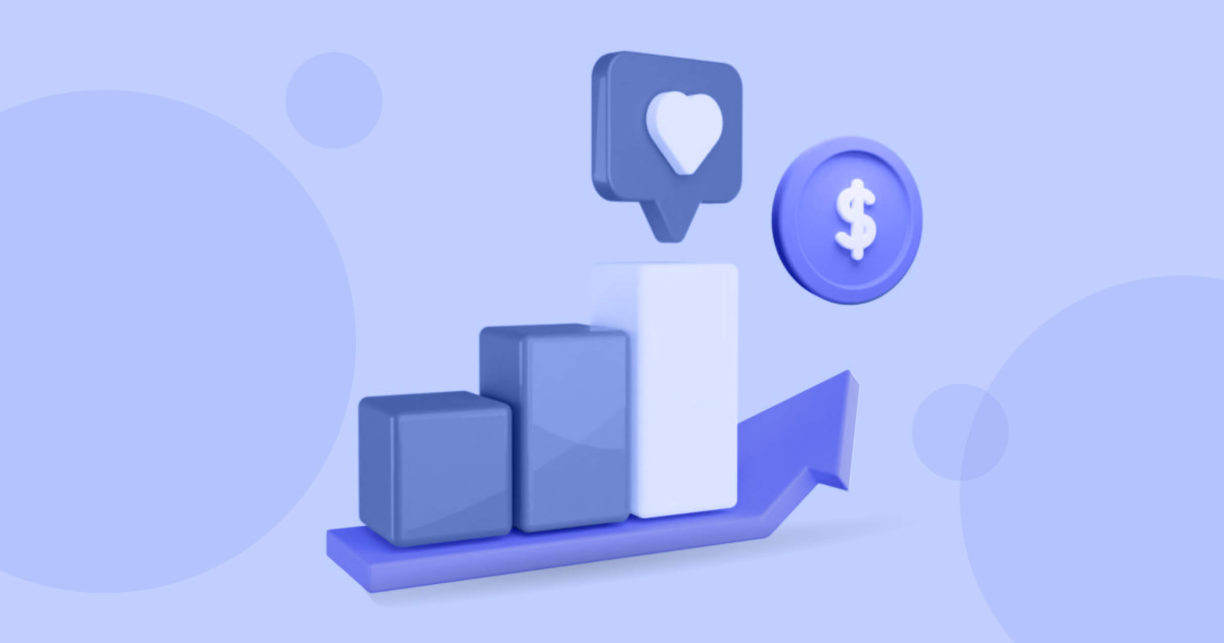When it comes to human behavior and understanding the key psychographic that forms decisions, putting a pin on it isn’t as simple as it may seem. There are several factors that influence people’s outlook, approach, and purchasing patterns; all of which marketers find hard to decipher.
In this blog, we’ll tell you how to unlock its potential for better marketing.

Reward customers with loyalty points every time they do what you want. Positive reinforcement can do magic!
What is Customer Behavior?
Consumer behavior means understanding the process and means of how audiences make end decisions. It includes focusing on their actions, engagement patterns, as well as usage or disposal of specific products or services – and the mental, emotional and behavioral responses that trigger those actions.
Why do marketers need to study it? Simply because the influence of psychology is a key factor in forming preferences, which eventually leads to purchases. The ability to connect with your audience right from the beginning of their journey, to instill trust and convey why and how you reign supreme over your competitors can win you life-long customers, a.k.a. recurring business opportunities.
Every business has an ICP and buyer personas they want to target. Consumer behavior marketing provides the fundamentals for understanding who you’re targeting and what potentially would interest them. Consumer behavior research provides the underlying element that drives quality strategies and ensures business results.
Think about Apple. Behind its winning marketing strategies and an ever-increasing number of customers who swear by its products is its ability to change with the shifts in consumer behavior. With iTunes capturing first-party data, or the company leveraging reference groups, or hooking people on product experiences, Apple invests greatly in understanding its customers.
As per their customers’ behavior, and preferences, Apple implements changes in its physical and digital elements to revamp its product offerings which in turn leads to customer delight.
Its monochromatic logo, feature updates, and brand messaging all are examples of how they use key-value propositions such as ease of use, sleek design, and exclusivity, to wow its customers.
After understanding how important is behavior analysis, the next obvious question would be: How to make your customers say yes to your products or services?
There are two categories of influences on consumer behavior:
External Influences
Demographics: an individual’s interests can be greatly influenced by demographics (age, gender, culture, etc.).
Social factors: surrounding people, such as family, friends education, social media, and purchasing power, all influence consumers’ behavior.
Internal Influences
Psychographics: Existing preferences, attitudes and beliefs can influence a customer’s association with your brand.
How Does Customer Behavior Prediction Work?
Customer Behavior prediction is all about unveiling your customer motivations. It helps marketers with advanced segmentation and targeting based on behavior.
Gathering information about how your customers engage with your brand can give you insights into what’s working and what’s not; helping you create campaigns that are contextually relevant and revenue-generating.
Customer behavior prediction comes in various ways. It can be through collecting information through primary or secondary research such as analyzing online actions, feedback analysis, focus groups, conversational marketing, and more.
Data analytics has enabled eCommerce shops to dive deeper into consumer behavior by analyzing actions such as purchase history, cart abandonment, sessions, search histories, or social media profiles.
For marketers to receive these bits of information in real-time, there are data analytics platforms that help reveal predictive insights, but most struggle with the quantity of data and effective reporting to strategically act on them.
How to forecast behavior through modeling
Predictive analytics is based on behavior modelling, which uses statistical significance to evaluate customers’ historical data and retrieve possible future actions. Modelling helps create a mathematical construct to highlight common behaviors among certain groups or segments of customers, which further hints at how similarly they’ll behave to different external stimuli.
Customer behavior models are created using aggregated customer data, and they can help answer many questions based on which brands can pivot their marketing. This helps bring out the best marketing outcomes for each group of customers, and also helps understand how and what customers base their decisions on (e.g., purchase, bounce, upsell, churn).
What are the Customer Behaviors You Should Analyze?
When it comes to online shopping, the Covid-19 surge, virtual convenience, as well as global access, have increased customers’ proclivity to buy online. In a recent survey, more than 65% of the customers vouched for online shopping than going into a store or event, etc. As it is established that ecommerce is positioned to grow, brands need to know how to capture customers’ attention and drive sales.
For this, data gathering and analysis have been fueling more and more marketing efforts. From social listening to feedback calls, AI-driven message boards and more – companies are constantly on the lookout for cues and changes in behavior. If interpreted well, they can bring out key insights to scale campaigns and create content that “clicks” with your audience. Some behaviors that ecommerce brands are increasingly keeping tabs on are:
Nature of the purchase: When you analyze customer behavior, knowing if the nature of the purchase – i.e. if it is habitual (buying often), impulse purchase, variety-driven, promotional, etc. can give you insights into purchasing patterns and how your customers would respond to different marketing campaigns.
Average spending: Knowing about the spending habits (high-spend, low-spend, etc) of your audience can help you understand their purchasing power and push relevant services/products to them.
Demographics: This is the most pressed upon factor. e Demographics include gender, age, income, location, and others.
Churn rate – Also known as customer attrition, it’s when a customer discontinues purchasing from a brand. It’s one of the easier metrics to calculate, predicting the probability that someone cancels or fails to renew.
Frequency and Recency: Learn more about how frequently customers engage with your brand and what is the average time interval between their purchases. This can help you target customers with one-time purchases or those with repeated purchases.
Preferred channel of engagement: Understanding what sources/ mediums/ channels your customers refer to for consuming information is essential to target them with the right message at the right time.
Its Relation to Machine Learning
The biggest marketing challenge is mastering the art of influence. And it becomes even more challenging when we know no two customers are alike. To track each customer’s intrinsic motivations, their actions, and preferences, aren’t humanly possible. Here is where humans leverage machine intelligence.
Human beings, although rational beings, have decision-making abilities that can be erratic, and not always defined by logic. Therefore, to the best influence, it is to observe and learn from it. Here is where machine learning comes into play. It can help you detect patterns not visible to the naked eye and estimate how existing and new customers are likely to engage.
Machine learning helps not just accumulate huge amounts of information about your customers but also establishes connections, builds segments and joins the dot between historical data and defining future customer behavior— i.e. what are their buying preferences, channel preferences, satisfaction levels and more.
However, predicting customer behavior through machine learning is only as good as the data available. Therefore, marketers need to make sure to constantly filter out archaic data and refer to specific data points that can derive meaningful conclusions.
How to Predict Customer Behavior in 4 Steps
1. Identifying prospects
Marketing today has been able to create one-on-one interactions with customers, but the catch is that these interactions are made precise and relevant by categorizing customers into certain segments.
Most companies start by building profiles of customers and clustering them with other customers that share the same traits. Data points such as demographics, geographic, product channels, and previous purchases can be used to segment customers.
But to create an even more advanced segmentation, you can leverage tools like Verfacto that capture technical attributes such as AOV, RFM (Recency, Frequency, Monetary Value, etc.), attention rate, sessions, returners, etc. for precise targeting.
2. Feature extraction to create profiles
Ask and evaluate critical questions like: who are your best customers, and why are they your customers? What do they buy, and why do they choose you over others? Based on that, you can identify the different engagement patterns of your customers and understand how to market them.
3. Create models to analyze customer behavior
Once you create your customer segments, machine learning can help predict their future actions, such as high/ low purchase intent, churn, preferred products, etc.
You can assign a certain bandwidth to each of these metrics (between 1-5 or 1-10). The idea is similar to lead scoring. This can help you better assess where each customer lies in terms of being a qualified/ unqualified lead.
Certain ecommerce analytics tools including Verfacto allow you to build clear identifications through data visualizations that help you compare and contrast each metric against the other – e.g. customer recency, frequency and monetary value of purchase.
4. Customizing communication to create a better pipeline.
By creating real-time customer profiles, you can clearly identify what communication you would want to trigger to a specific segment. Teams can utilize this information to create campaigns for their high-intent/ medium or low-intent prospects.
For example, the leads that are on the top of the funnel, content that is less sales-oriented and more informative, and value-driven (blogs, videos, infographics) can help you build the trust among visitors that ultimately leads to purchases.
While middle or bottom-funnel leads, who are aware of their problem and are looking for solutions, can be benefited from brand-driven content such as case studies, testimonials, live events, etc., to put more weight on your end when comparing other competitive offers.
Personalization in marketing and sales is a proven approach that creates a better pipeline, and opportunities, and helps improve the stage-to-stage conversion rate.
The 5 Best Tools to Predict it
Each customer behavior analytics tool offers different insights into your users’ preferences and actions. While some tools can help you see the page-on-page engagement on your website or how are they moving forward through the funnel; others can get granular and capture different customer attributes and also yield out how they are interacting with specific elements.
If you wonder which tool would be the best fit for your eCommerce store, here are some of our top picks:
1. HubSpot
HubSpot is a CRM (Customer Relationship Manager) that offers brands to personalize their marketing outreach through behavioral targeting. It tracks behaviors based on customer personas and engagement activities such as web visits, email interactions, form submissions, etc.
You can leverage the tool to identify high-intent behaviors and develop journeys that bring your customers to a purchasing point. HubSpot is being currently used by more than 113,000 companies around the world.
2. Optimizely
Optimizely helps ecommerce brands move beyond just tracking data regarding churn, and conversions, to offering experience analytics that helps understand and optimize the entire customer journey. Often instating themselves as a digital experience platform (DXP), Optimizely helps brands create strategies that conform to customer behavior, preferences, and history.
With Optimizely, you can collect data at different touchpoints, monitor behavior across your channels and use the information to make intelligent decisions for each digital interaction.
3. Google Analytics
Being long in the game, Google Analytics has managed to stay relevant even with new-age tools emerging. Along with tracking standard metrics such as sessions, clicks, and conversions, the tool allows ecommerce brands to capture even more detailed interactions using event tracking.
For ecommerce business, in particular, Google Analytics offer “Enhanced Ecommerce” tracking to understand user behavior across their online experiences. With the tool being more or less sufficient, it is typically used by brands in tandem with other analytics tools for conducting behavior prediction.
Google Analytics is user-friendly and is the top choice for brands to analyze their website performance, study channel engagements, and create goals. Along with that, the reporting options are quick and comprehensive.
4. Verfacto
Verfacto is a new-age ecommerce analytics tool that answers and solves challenges in today’s ecommerce marketing. This ranges from helping brands capture customer behavioral attributes to hyper-targeting, building and enriching customer experiences to driving campaign performances through contextual communication.
The tool helps convert raw and aggregate data into actionable insights, all in real-time, so that eCommerce stores can pivot by the minute. Apart from behavioral analytics, advanced segmentation and customer profiling, you can use the tool to create precise reports that inform about essential metrics.
5. Woopra
Woopra is an end-to-end customer journey and product analytics tool. It offers real-time insights into every action that your customers are taking including checkouts, web visits, open rates, etc. all in one platform. You can put the user behavior data to use by optimizing your marketing campaigns, identifying gaps in existing processes, and improving the customer experience on your site.
It also offers customer journey reports and visualizes the browsing patterns so that marketers can study them more critically. You can also retrieve cohort reports to analyze and compare growth trends over time.
How To Forecast and Influence Customer Behavior In Real-Time with Verfacto
Understanding your customers’ motivations is key to serving them better, which ultimately brings tangible value to your business. With Verfacto, analyzing customer behavior begins with realizing answers to the questions such as:
What have been the customers’ previous proclivities, and actions? (historical data)
What are the factors influencing a customer to make purchase decisions?
Why does a customer prefer one product/service over the other?
How to segment them based on their interests, behavioral attributes or stage in the journey?
Through these questions, brands can perform customer behavior predictions that help better their marketing efforts. With Verfacto’s Real-time customer Profiler, businesses can clearly segment audiences based on behavior in the current session, customer historical data and Behavioral historical data.
These attributes, which are further classified into certain events, can offer insights into buying intents, help optimize funnels and more. Brands can leverage the insights to further communicate their relevancy to customers, making them their preferred choice for online purchasing.
Real-time customer profiler is a giant leap forward from manual to analytics-fueled marketing. Removing the time and effort constraints of mapping multiple customer events to produce actionable information, this feature can just be activated with an on-site tracking script. Learn more here.
Conclusion
In the ecommerce landscape, the customer is the king. So, there’s a constant battle between brands to not just catch the eye, but retain themselves in customers’ minds too. And the only way to do it is to work in their best interest- understanding the “why” of every purchase and bringing the “when” and from “who” in your favor.
Thanks to behavioral analytics tools, marketers can now track, record, and influence customer behaviors, all to improve user experiences. But how successful they get depends on the data they capture, as it should be contextual and structured.
Furthermore, choosing a tool custom-made for ecommerce business would be a smart choice. Tools such as Verfacto offer real-time insights that can help you gain an edge when it comes to optimizing strategies for ever-changing brand-customer dynamics!

